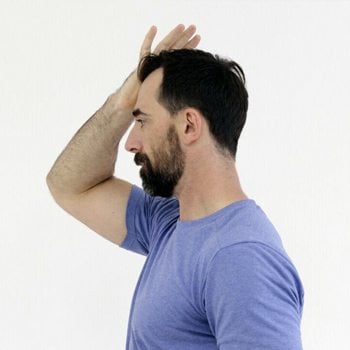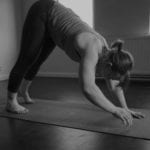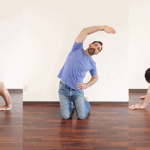Imagine carrying around a 10-pound bowling ball in your hand all day. This is what your neck does for you day-in and day-out.
 Luckily that’s what it’s designed for, but with all the stresses and everything that needs to be done in our lives, sometimes those demands get just beyond our capacities and we feel it in our necks.
Luckily that’s what it’s designed for, but with all the stresses and everything that needs to be done in our lives, sometimes those demands get just beyond our capacities and we feel it in our necks.
All the coordination and control we need from our necks to help us to walk, drive, read, react to unexpected surprises, and engage in basically all physically demanding activity.
It’s a lot!
And I think it’s very important to reframe it in this way, we can absolutely build and bolster the capabilities and resilience of our bodies to match all of our daily physical responsibilities, as well as our recreation and sports. We are adaptable and capable, we just need to know how to improve our capacities.
With dedicated work on improving the combination of strength, mobility, and motor control in the neck, you’ll see improvements in your current issues (if you have any), and set yourself up well with better resilience in the future.
In this article, we’ll cover:
- Some basics on how the neck works
- Common neck pains and problems
- A simple exercise routine for neck health
Before we dive in, I just want to remind you that the information in this article is no substitute for being seen by a professional in-person if you have ongoing issues–particularly related to pain or weakness.
🆓 Assess and Address Your Chronic Stiffness and Pain with our Body Maintenance Guide
- Based on physical therapy and pain science
- Head-to-toe diagnostics for the most common movement restrictions
- Specific interventions and preventative exercises
What You Need to Know About Your Neck
You don’t need to memorize the complete anatomy and physiology of your neck to get started on improving how you feel, but it’s helpful to have a good general understanding of what’s happening “under the hood.”
A bit of knowledge removes some of the mystery so you can visualize and be aware of the various structures and actions of your neck. Of course, health care specialists spend years studying this, but a few paragraphs and minutes of your time are all that’s necessary for most people’s needs. Learning is great, but we want it to help you move forward, not get you stuck worrying about all the things that could go wrong.
Basic Structure and Function of the Neck
There are 7 bones in the neck, with different shapes and sizes. They comprise the portion of the spine we term the cervical” which begins just below your skull (C1), and runs down to that big bony prominence (C7) at the top of your back.
The upper cervicals (C1-C2) are responsible for 50% of the rotation that occurs in the head, while the lower cervicals (C3-C7) are responsible for flexion, extension, side bending, and the remaining 50% of rotation.
 As for the muscles, there are at least 13 that feed into the neck and allow it to function properly. These connect to the head, the shoulders, and the upper back.
As for the muscles, there are at least 13 that feed into the neck and allow it to function properly. These connect to the head, the shoulders, and the upper back.
Forward/backward/side bending and rotation and every combination of those motions happens everyday without us thinking about it, until we feel a problem!
Here’s a few example names to look at and then immediately forget 🙂
- Flexion and Sidebending and Rotation: Sternocleidomastoid, Rectus capitis anterior and lateralis, Longus colli and capitis, Scalenes
- Extension and Sidebending and Rotation: Trapezius, Splenius Capitis and Cervicis, Semispinalis capitis and cervicis, Multifidis cervicis
- Stabilizers: And a dozen or so small muscles between the skull and the spinal joints that help keep your head steady.
With so many moving parts, things can get quite complicated, as I’m sure you can imagine.
There are obviously many more details I could go into and it’s something I specialized in for quite a long time, but for practicality’s sake, let’s focus more on common issues in the neck, and how to address them.
Common Neck Pain Issues
Because the neck is made up of such a complex system of small and large intertwined muscles, ligaments, nerves, and bones, and owing to the fact that you are carrying your brain around in it, the area can become sensitized to irritations.
Remember that pain is an alarm system which goes off with the perception of a threat to the stability of our bodies. Whether that’s an actual trauma – getting hit or from falling – or from overdoing it a bit at your family Thanksgiving flag football game, the neck can bear the brunt of a lot of this and can be quick to sound the alarm.
It can seem simplistic but issues really do fall under the two primary categories: Tightness/Pain and Weakness.
Tightness and/or Pain
 One of the most common complaints are sensations of “tightness” throughout the neck and upper shoulder girdle. The various tensions and stresses of our daily lives can contribute to a reaction of the nervous system and muscles to “stiffen” as a protective mechanism.
One of the most common complaints are sensations of “tightness” throughout the neck and upper shoulder girdle. The various tensions and stresses of our daily lives can contribute to a reaction of the nervous system and muscles to “stiffen” as a protective mechanism.
This tightness can be lessened with proper exercise and stress reduction techniques. That doesn’t mean it doesn’t exist or is “all in your head,” it simply means that it is capable of being changed relatively quickly when you begin working on it.
And one of the reasons that this self-protective tension persists is from the often limited ways we use our necks. Most people don’t take their neck through its full range of motion in day-to-day activities, and as we all know, the “use it or lose it principle” is quite real. We have a tendency to hold our heads in fairly static positions, and that can cause tightness over time.
Here’s an interesting phenomenon, and something that accounts for part of why so many of our clients report decreased stiffness and soreness from doing our programs even though there doesn’t appear to be any dedicated neck exercises. And it’s the concept of relative motion.
View this post on Instagram
When moving your head around is stiff and sore, it’s normal to not want to move it! But motion is what you need to do, and switching it up so that you move your body underneath your head can help lessen that protective response. Since your head is relatively steady, it dampens the alarm a bit and lets you get that motion in a less stressful way.
This is an example of why our clients tell us that our locomotion programs, which involve full body purposeful movement, have many indirect benefits.
Weakness
 While not quite as common as the complaint about tightness or pain, another prevalent issue is weakness in the neck. This is obviously connected to those cricks and tweaks, and can often be a cause of those issues.
While not quite as common as the complaint about tightness or pain, another prevalent issue is weakness in the neck. This is obviously connected to those cricks and tweaks, and can often be a cause of those issues.
We need our necks to be strong, primarily to give ourselves the sensation of stability, to keep all the sensitive structures feeling secure and stable. When your neck gets jerked or taken through a range of motion that feels unstable, the brain responds by tensing up the muscles to protect the neck. Often with the pain alarm signal.
Good fundamental strength in the neck is important, and the exercises below will take care of the majority of our needs. Most of us don’t need necks of steel unless we participate in combat sports or football.
As mentioned before, there can be musculoskeletal origins for such symptoms as headache, pain, dizziness, etc. But there can be other causes for those issues as well, so please see your health care provider before doing anything else!
Supplemental Routine for Neck Health
In the following routine, I’ve emphasized exercises that address, not just strength and mobility, but also the motor control aspect that is so often neglected.
As always this isn’t meant for you to do forever, but if you are having some issues and regular exercise hasn’t been doing the trick, working through this routine a couple of times a week, or more often if necessary, often helps people feel better very quickly.
Here’s an overview of this routine, with details on each exercise below the table:
| Body Position | Movements/Holds |
|---|---|
| Supine (lying on back) | • Rotations • Sidebending with Rotations • Sidebending with Rotation and Lift • Upper Cervical Flexion • Upper Cervical Flexion with Sidebending |
| Sitting | • Chin to Chest with Rotation • Chin to Chest with Sidebending • Rotated with Sidebending • Sidebent with Rotation • Levator Scap Stretch • Upper Trap Stretch |
| Quadruped (all fours) | • Retraction • Retracted with Rotation • Retraction with Rotation and Sidebending • Low Trap Raise |
Supine Exercises (Lying on Back)
 All of the exercises in this series start with you lying on your back in a comfortable position.
All of the exercises in this series start with you lying on your back in a comfortable position.
- Rotations–Simply rotate your head from left to right, moving slowly and with control.
- Sidebending with Rotation–Sidebend your head 45-degress to one side, then slowly rotate to the left and right. When you’ve completed one side, sidebend to the other direction and repeat.
- Sidebending with Rotation and Lift–Sidebend your head 45-degress to the right, rotate the head to the right, and then lift the head slightly off the ground. Repeat on the other side.
- Upper Cervical Flexion–Keeping your head straight and on the ground, roll your chin towards your chest to flex your upper cervicals. The axis of rotation for this movement is through your ears (think about a rod sticking straight through your ears, and you are rotating around that rod).
- Upper Cervical Flexion with Sidebending–Sidebend your head 45-degrees to the right, then do the same action as the previous upper cervical flexion. Repeat on the other side.
For each of these exercises, aim for 3 sets of 5-10 repetitions.
Seated Exercises
 This series of exercises should be done from a seated position, however you can do that.
This series of exercises should be done from a seated position, however you can do that.
If you feel comfortable sitting crosslegged or in a seiza position on the ground, that’s great, but these can also be done from a chair–whatever is comfortable for you.
- Chin to Chest with Rotation–Flex your chin down toward your chest, and then rotate from left to right.
- Chin to Chest with Sidebending–Flex your chin down toward your chest, and then sideband to the left and to the right.
- Rotated with Sidebending–Rotate your head to the right and sidebend to the right and to the left. Then switch sides.
- Sidebent with Rotation–Sidebend your head to the right, then rotate from left to right. Then switch sides.
- Levator Scap Stretch–For this stretch, clasp your hands behind your back, rotate your head 45 degrees to the right, then tuck your chin down toward your chest. Hold, then switch sides.
- Upper Trap StretchFor this stretch, clasp your hands behind your back, and sidebend to the right. Hold, then switch sides.
For the first 4 exercises, aim for 3 sets of 5-10 repetitions. For the last two exercises, hold each stretch for a total of 60 seconds, starting with whatever you can hold. So, if you start with a 10-second hold, you’ll want to do 6 sets of 10 seconds; if you start with a 20-second hold, you’ll do 3 sets of 20 seconds, adding up to 60 seconds total.
Quadrupedal Exercises
 In this series, you’ll be on your hands and knees on the ground. If you need cushioning under your knees or ankles, feel free to use that.
In this series, you’ll be on your hands and knees on the ground. If you need cushioning under your knees or ankles, feel free to use that.
- Retraction–Keeping the rest of your body (including your shoulders) stable, jut your chin down to the ground, then retract your head backward.
- Retraction with Rotation–Go through the same jutting and retracting motion, but this time, when you retract the head, rotate it from side to side.
- Retraction with Rotation and Sidebending–Now, when you rotate to one side, add a side bending motion toward that side shoulder. Be sure to repeat on both sides.
- Low Trap Raise–For this last exercise, you’ll drop down into prayer position (or “child’s pose”). Retract the scapula and rotate the shoulder outward, as you bring your hand out to the side.
For these exercises, aim for 3 sets of 5-10 repetitions.
Emphasize the Motions Your Neck Needs
 We need to move our head in a multitude of directions and angles throughout the day, whether it’s simply sitting at a desk working on the computer and looking all around in everything you need to do, or playing a pick up game of basketball on the weekend.
We need to move our head in a multitude of directions and angles throughout the day, whether it’s simply sitting at a desk working on the computer and looking all around in everything you need to do, or playing a pick up game of basketball on the weekend.
The straightforward motions of Rotation, Sidebending, Flexion (forward bending), and Extension (backward bending) take your neck through its full ranges and any restrictions there can be quickly felt when you try to go through your normal routines.
But you also need the ability to combine these motions for proper neck function.
This includes:
- Rotation and sidebending together when you look up and to the side at something overhead without moving your whole body.
- Or flexion and rotation as in partially sitting up in bed to turn and glare at your alarm clock going off.
This is why the exercises we’ve shown above highlight different variations of combined motions. They are often neglected, so their practice will give you a good way to restore proper movement and control of your neck.
Just as we iterate in the GMB Method, you want to properly address Strength, Flexibility, and Motor Control in their appropriate intensities and emphases.
Keep Your Body Healthy and Functional
 The above routine is an example of focused and direct training which may be necessary for some neck pain and complaints. And the best way to keep your neck–and all your muscles and joints–healthy and functional throughout your life is to keep them moving as much as possible.
The above routine is an example of focused and direct training which may be necessary for some neck pain and complaints. And the best way to keep your neck–and all your muscles and joints–healthy and functional throughout your life is to keep them moving as much as possible.
But you shouldn’t think you need to always be doing this focused work for every body part forever! A comprehensive, whole body exercise program should be capable of maintaining every part of your body.
Build A Capable and Resilient Body
Our Elements program encompasses full body movement patterns to improve confidence in your ability to move smoothly and with control through any range of motion.






